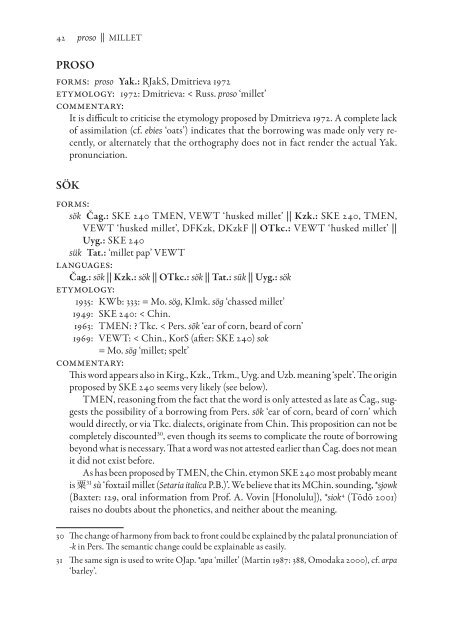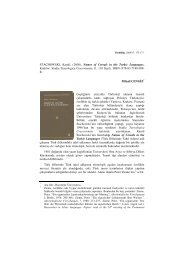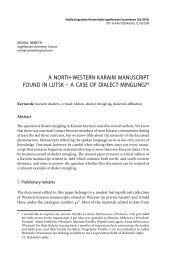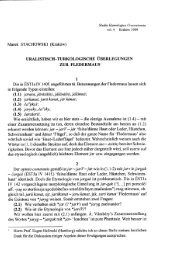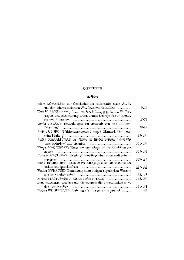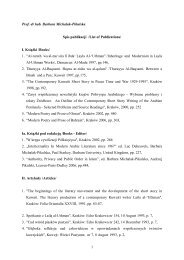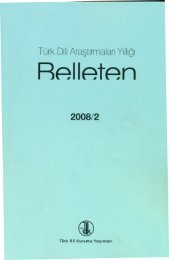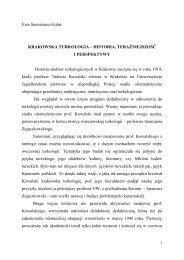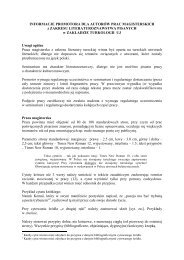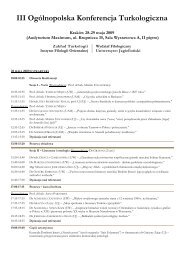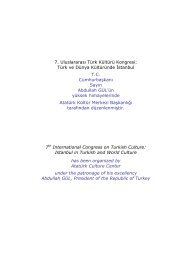Names of Cereals in the Turkic Languages - Wydział Filologiczny UJ
Names of Cereals in the Turkic Languages - Wydział Filologiczny UJ
Names of Cereals in the Turkic Languages - Wydział Filologiczny UJ
- No tags were found...
Create successful ePaper yourself
Turn your PDF publications into a flip-book with our unique Google optimized e-Paper software.
42 proso || Milletpros<strong>of</strong>orms: proso Yak.: RJakS, Dmitrieva 1972etymology: 1972: Dmitrieva: < Russ. proso ‘millet’commentary:It is difficult to criticise <strong>the</strong> etymology proposed by Dmitrieva 1972. A complete lack<strong>of</strong> assimilation (cf. ebies ‘oats’) <strong>in</strong>dicates that <strong>the</strong> borrow<strong>in</strong>g was made only very recently,or alternately that <strong>the</strong> orthography does not <strong>in</strong> fact render <strong>the</strong> actual Yak.pronunciation.sökforms:sök Čag.: SKE 240 TMEN, VEWT ‘husked millet’ || Kzk.: SKE 240, TMEN,VEWT ‘husked millet’, DFKzk, DKzkF || OTkc.: VEWT ‘husked millet’ ||Uyg.: SKE 240sük Tat.: ‘millet pap’ VEWTlanguages:Čag.: sök || Kzk.: sök || OTkc.: sök || Tat.: sük || Uyg.: söketymology:1935: KWb: 333: = Mo. sög, Klmk. sög ‘chassed millet’1949: SKE 240: < Ch<strong>in</strong>.1963: TMEN: ? Tkc. < Pers. sōk ‘ear <strong>of</strong> corn, beard <strong>of</strong> corn’1969: VEWT: < Ch<strong>in</strong>., KorS (after: SKE 240) sok= Mo. sög ‘millet; spelt’commentary:This word appears also <strong>in</strong> Kirg., Kzk., Trkm., Uyg. and Uzb. mean<strong>in</strong>g ‘spelt’. The orig<strong>in</strong>proposed by SKE 240 seems very likely (see below).TMEN, reason<strong>in</strong>g from <strong>the</strong> fact that <strong>the</strong> word is only attested as late as Čag., suggests<strong>the</strong> possibility <strong>of</strong> a borrow<strong>in</strong>g from Pers. sōk ‘ear <strong>of</strong> corn, beard <strong>of</strong> corn’ whichwould directly, or via Tkc. dialects, orig<strong>in</strong>ate from Ch<strong>in</strong>. This proposition can not becompletely discounted 30 , even though its seems to complicate <strong>the</strong> route <strong>of</strong> borrow<strong>in</strong>gbeyond what is necessary. That a word was not attested earlier than Čag. does not meanit did not exist before.As has been proposed by TMEN, <strong>the</strong> Ch<strong>in</strong>. etymon SKE 240 most probably meantis 粟31sù ‘foxtail millet (Setaria italica P.B.)’. We believe that its MCh<strong>in</strong>. sound<strong>in</strong>g, *sjowk(Baxter: 129, oral <strong>in</strong>formation from Pr<strong>of</strong>. A. Vov<strong>in</strong> [Honolulu]), *siok 4 (Tōdō 2001)raises no doubts about <strong>the</strong> phonetics, and nei<strong>the</strong>r about <strong>the</strong> mean<strong>in</strong>g.30 The change <strong>of</strong> harmony from back to front could be expla<strong>in</strong>ed by <strong>the</strong> palatal pronunciation <strong>of</strong>-k <strong>in</strong> Pers. The semantic change could be expla<strong>in</strong>able as easily.31 The same sign is used to write OJap. *apa ‘millet’ (Mart<strong>in</strong> 1987: 388, Omodaka 2000), cf. arpa‘barley’.


